Fujifilm X-T20 Mirrorless Camera Review
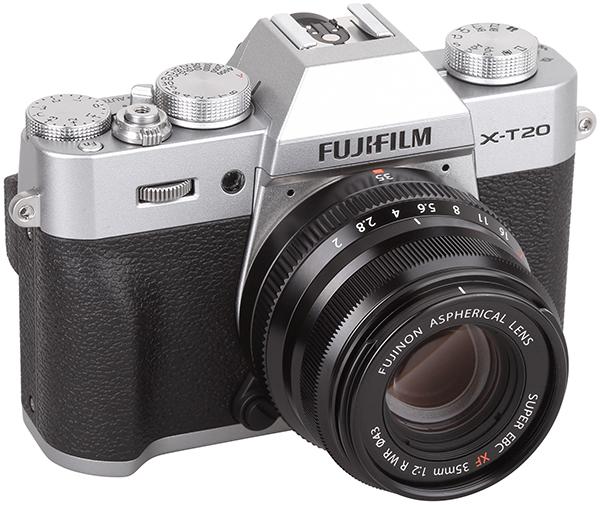
(Editor’s Note: Lab Review lab tests and comments are supplied by BetterNet, Shutterbug’s TIPA-affiliated testing lab and edited by George Schaub. TIPA is a worldwide association of photo and imaging magazines.)
The Fujifilm X-T20 is a mirrorless system camera with a 24MP sensor that was developed by Fujifilm. This “X-Trans CMOS III” sensor is already used in Fujifilm’s top-of-the-line X-T2 and X-Pro2 mirrorless cameras. To optimize detail reproduction and sharpness the sensor doesn’t use a low-pass filter: it uses the unique “X-Trans” RGB pattern instead of the standard Bayer pattern.
Features, Build & Handling
The Fujifilm X-T20 doesn’t offer an image stabilizer system based on sensor shift technology. But Fujifilm offers X-mount lenses with built-in Optical Image Stabilization (OIS-type lenses), such as the standard zoom Fujinon XF18-55mm f/2.8-4 R LM OIS and the tele-zoom Fujinon XF100-400mm f/4.5-5.6 R LM OIS WR.
The Fujifilm X-T20 features a combination of a mechanical and an electronic shutter system. The menu has an option to use this “double” system in auto mode, but the photographer can toggle manually between both shutter systems if desired. Using the mechanical shutter system allows the photographer to take images with a top shutter speed of 1/4000 second: using the electronic system will offer up to 1/32,000 second.
The Fujifilm X-T20’s other options include exposure settings up to 30 seconds and a “bulb” mode for exposures up to 60 minutes. Activating the electronic shutter system also allows for higher-speed continuous shooting. With the mechanical shutter it offers up to 8 frames per second (fps) and a burst of 62 JPEGs: with the electronic shutter it’s up to 14 fps and a maximum of 42 JPEGs.
We note that the Fujifilm X-T20’s menu is extensive and at times creates situations where functions and settings seem to cancel each other out, thus requiring good study of the camera manual (see below for examples). Nevertheless, the Fujifilm X-T20 has numerous function buttons, setup dials, and parameter wheels that once mastered offer a very wide variety of photographic options.
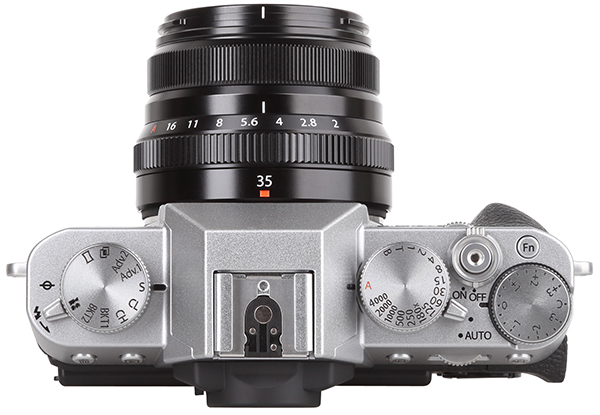
The parameter dials are located on the back and front of the Fujifilm X-T20: the back dial can be reached by the thumb of the right hand very easily, although due to the very thin body it is a little difficult to use the back dial and front dial simultaneously. Using the middle finger of the right hand to operate the front dial, the forefinger for the shutter release button, and the thumb of the right hand for the dial on the back allows the photographer to use all three elements simultaneously (one after another without interruption).
In addition to its parameter dials, the Fujifilm X-T20 has a shutter speed dial on top, which offers standard settings at intervals of 1 EV stop (with the exception of a 1/180 second setting between 1/125 and 1/250). To use intermediate steps, the photographer can use the dial on the back. When the camera is set to 1/60 second, for example, the electronic menu allows for settings from 1/40 to 1/100 in 1/3 EV steps.

The Fujifilm X-T20 offers a mode dial on the top to choose single shot photo mode, 2x continuous shooting modes, video mode, double exposure mode, advanced modes for special effects, bracketing modes, panorama mode (2160x9600 pixels), and more. A small lever directly at this mode wheel activates the pop-up flash.
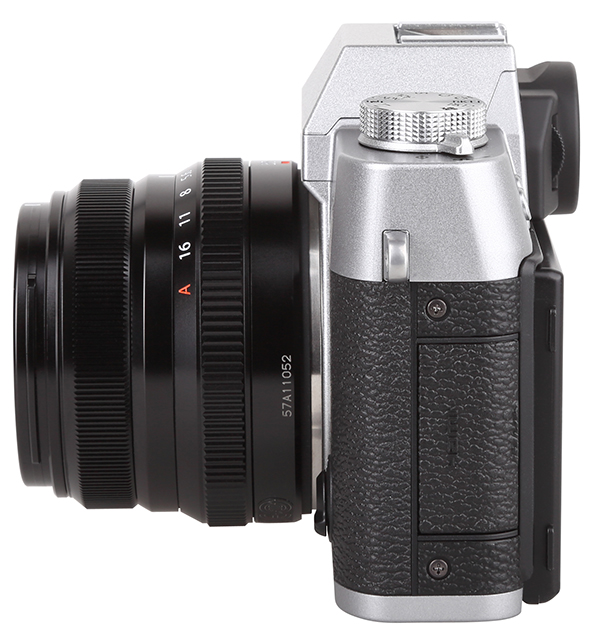
The third dial on the top of the Fujifilm X-T20 is located on the right-hand side. This adjustment wheel allows for setup of the EV compensation by plus/minus three stops. Directly in front of this wheel is a function button (labeled “Fn”). Many function elements are user definable. The photographer can choose functions for the four buttons of the control field on the back, for the “Fn” button on the top, and much more.
The X-T20 camera features Fujifilm’s famous film simulation modes, which mimic analog film material and styles. These styles are based on Fujifilm’s real films like Provia, Velvia, and Astia, while the “Classic Chrome” mode simulates Kodachrome. In addition, the X-T20 offers black-and-white film styles. All these settings can also be used for video recording. In addition to film simulation the camera offers various film grain effects.
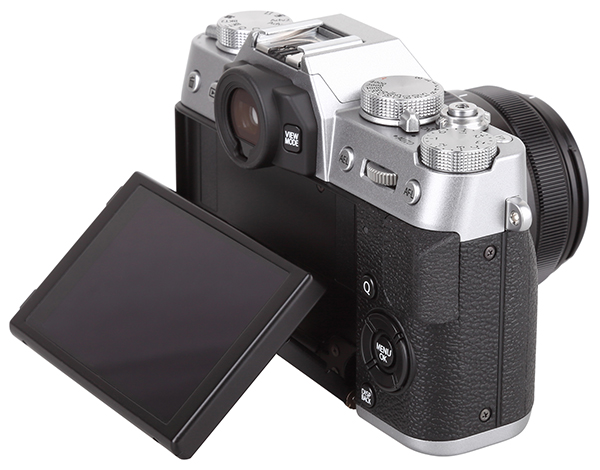
As mentioned, setups for imaging options on the Fujifilm X-T20 can be a little difficult, because a) the translation of technical terms is unusual and b) many of these settings create “mutual impacts” which aren’t always obvious. For example, setting the small lever at the shutter speed dial to auto mode shuts off or limits the film simulation options. Using the DR Auto mode (instead of DR100%, DR200%, and DR400%) deactivates the program shift function that normally allows the photographer to change shutter speed and aperture size when working in autoexposure mode.
Comments on Image Quality
Color: The Fujifilm X-T20 showed an excellent performance in our color tests. White balance is nearly perfect and has only a minor shift into the bluish and magenta area of the color space. Brighter skin tones are reproduced very well, although darker skin tones have a tendency toward a high yellow/orange range. All color tests were done in Fujifilm’s standard color setting, which is similar to the Provia film simulation.
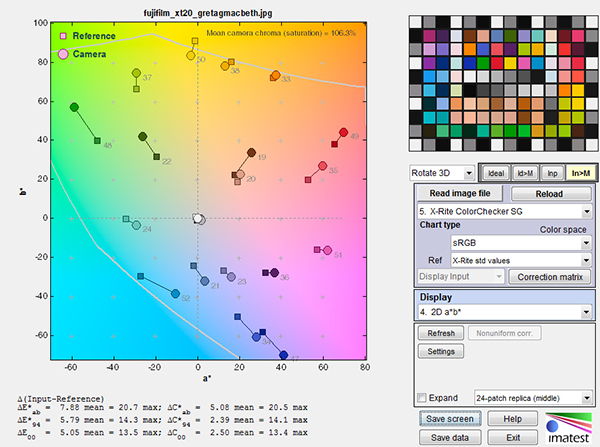
Sharpness: The X-T20 reproduced the ISO 12.233 test chart with 3,388 of 4,000 lines per pixel height. Electronic sharpening effects in all images are visible on hard contrast lines, but on an acceptable level and comparable to the results of most other mirrorless cameras with an APS-C-sized sensor. Enhancement of the image by the X-T20 image processor is visible in our portrait shot. While hard contrast lines like the eyelashes (right eye of our model) show hard contrast and are enhanced, the skin tone and hair of our model have a smoother look. Overall, the camera showed very nice and natural colors.
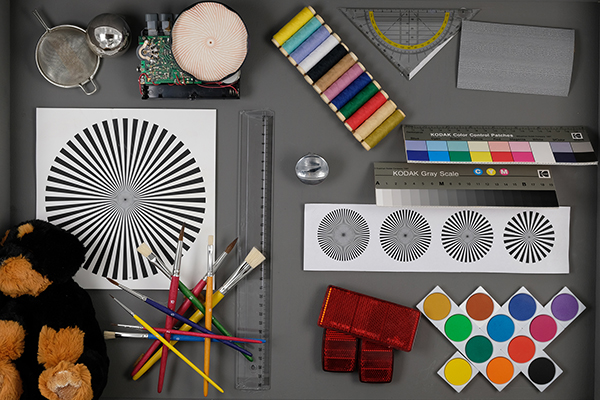
Noise: The X-T20 performed very well in our noise tests. The Y noise factor stays below the 1.0 percent line up to ISO 6400. Even at ISO 12,800 the camera reproduction reaches only 1.10 percent, which is very good. The camera uses a filtering system to reduce color noise effects. This filter works unobtrusively even at ISO 12,800 and yields very good reproduction of fine details. Images taken at ISO 6400 or ISO 12,800 look like those taken with high-speed film material.
The dynamic range results are a little disappointing. At ISO 400 the camera achieved a maximum of 10.7 f/stops, but dynamic range drops when using ISO 800 to ISO 3200.

Comments on Video Functions
The Fujifilm X-T20 offers Full HD video recording with 1920x1080 pixels and 4K recording with 3840x2160 pixels (UHDTV). Both resolution modes can be used with different frame rate settings. In 4K the camera is able to record up to 30 fps (29.97 fps): in Full HD it will record up to 60 fps (59.94 fps). In addition, it has NTSC- and PAL-compatible modes so it can use frame rates on a basis of 30 fps and 25 fps. It also can record videos in “cinema modes” with 24 fps.
The Fujfilm X-T20 uses Apple’s QuickTime file format MOV as a “container” for its MP4/H.264 compressed video files. In its video setup menu the camera offers an additional “SD card/HDMI” setting, which allows video recording on an external system. It’s a “clean HDMI signal” without overlay elements like info on exposure settings.
The X-T20 camera doesn’t have a second shutter release button to start video recording (while it is still in photo mode). The photographer has to switch the mode dial on the top to its “video” position to start video recording with the standard shutter button.
The Fujfilm X-T20 offers full manual exposure control in video mode. By using the aperture ring on the lens system it will work in “A” mode and vice versa using the shutter speed wheel to set up a desired shutter speed. Using both setup systems will switch the camera to “M” mode. In addition, the photographer can use manual ISO speed settings.
For manual focusing the camera features a focus magnifier function and “focus peaking.” Both helpers will start when the camera is in manual focus mode and the photographer starts moving the focus lens ring. The photographer can use manual sound level control (three steps of sound levels are available) and an external microphone. When the combi interface (mic/remote) is set to “mic” for an external microphone the sound level control is deactivated: this means that the microphone needs to utilize its own sound level control system.
Comments on Video Quality
The Fujifilm X-T20 showed very good results in our video resolution tests. In 4K mode it reproduced the ISO 12.233 chart with 1,628 of 2,160 lines: in Full HD mode it recorded videos with 926 of 1,080 lines. Subjective perception of sharpness seems to be a little lower. The camera showed videos with hard contrast, with a slight muddying of fine details.
Color reproduction is similar to photo mode: the automatic white balance system works perfectly. In our color result chart all neutral gray patterns are located in the center of the graphic. Skin tones are reproduced perfectly, while some red and blue nuances are a little exaggerated. The camera showed very good results in our noise tests, but the dynamic range test is a little disappointing. The camera achieved a maximum of 8 f/stops.
The Fujifilm X-T20 (body only) has a list price of $899. For more information, visit fujifilmusa.com.
Scorecard
Pros
+ Compact and stylish mirrorless system
+ Very good image quality, very nice skin tone reproduction
+ A lot of features and individual settings
+ Swivel LCD monitor
Cons
- Missing internal image stabilizer (Fujifilm offers X lenses with optical image stabilizer)
- Some function elements are really small
- Some menu items and settings are a little cumbersome
(Lab Review is where we publish web-exclusive lab reports on cameras. To read more Lab Reviews, click on the Reviews tab on the top navigation bar of this page. New photo gear reports are published frequently, so check Reviews for more equipment evaluations from Shutterbug writers.)

















































